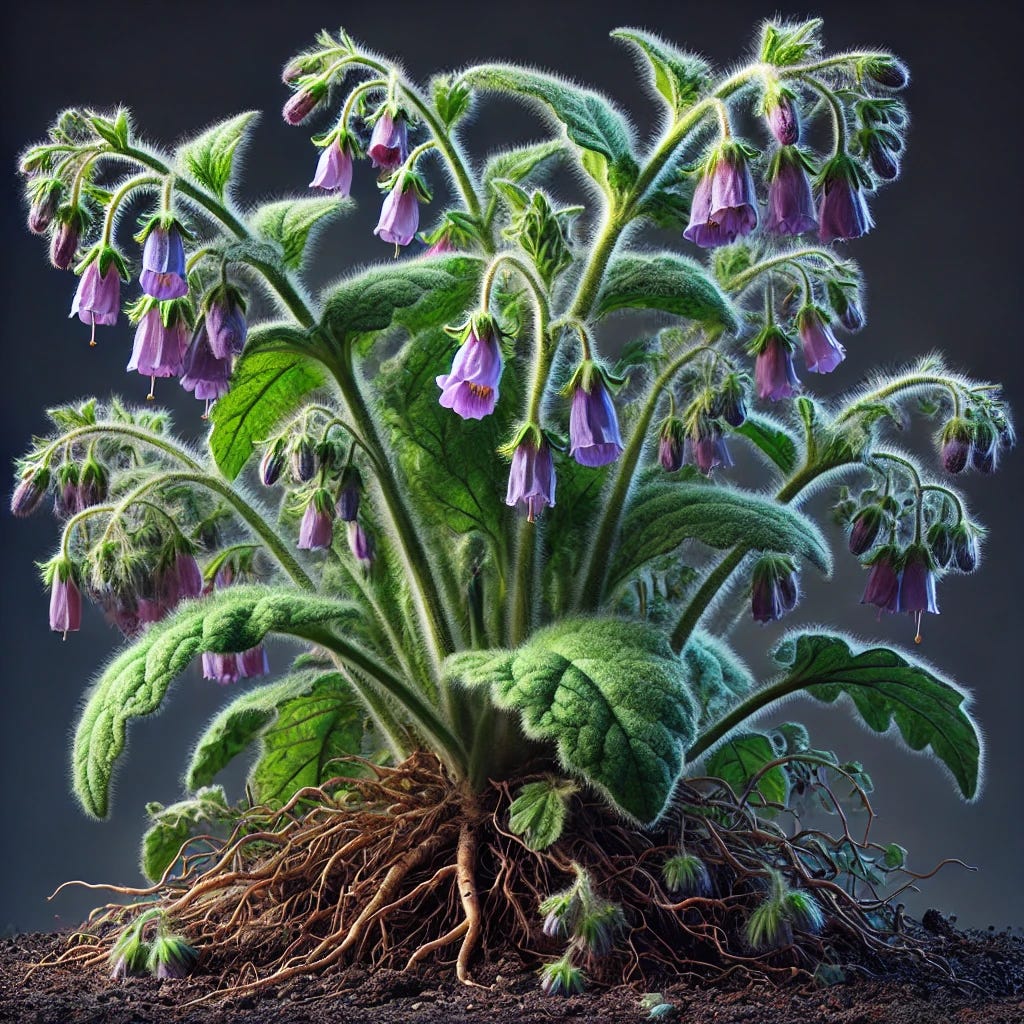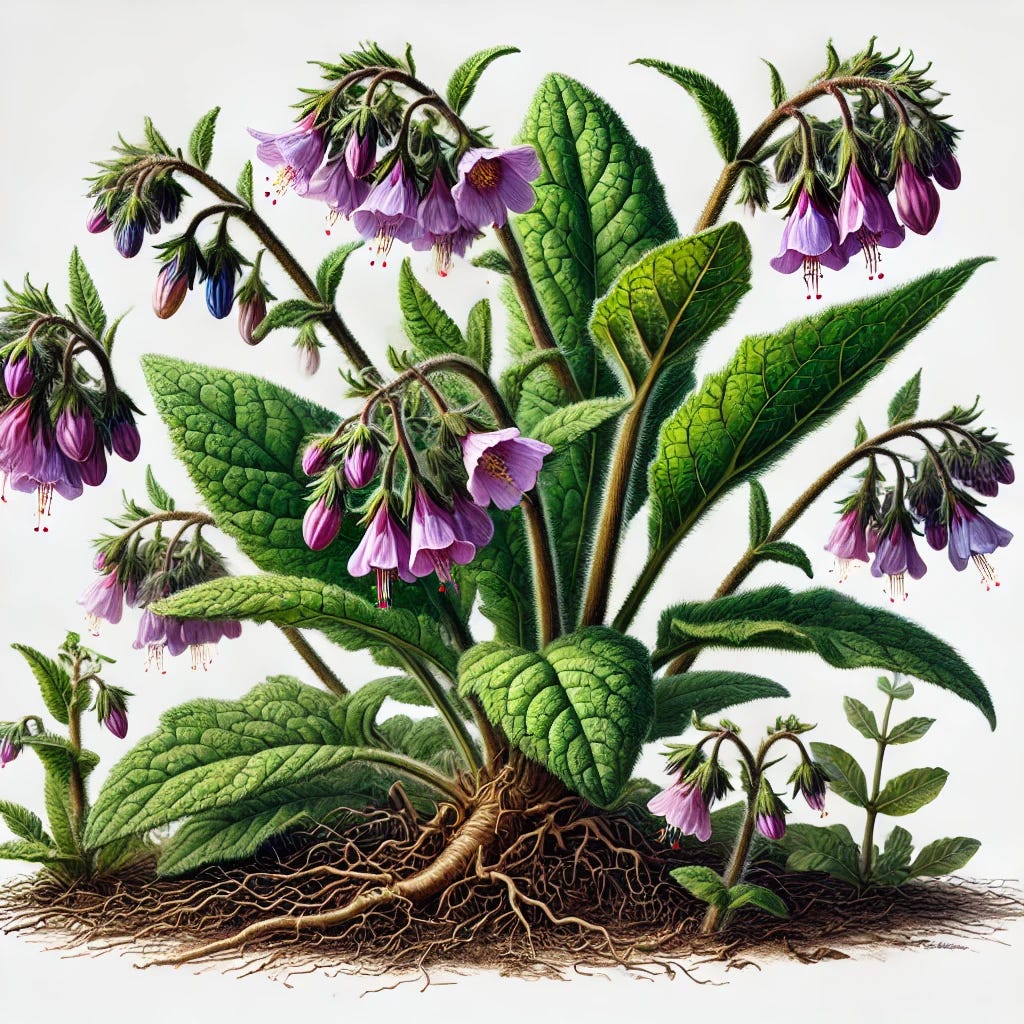Comprehensive Guide to Comfrey
I. Introduction
Comfrey (Symphytum officinale) is more than just a perennial herb; it's a cornerstone in regenerative agriculture. Known for its remarkable ability to accumulate nutrients and improve soil health, comfrey has been used for centuries in both traditional medicine and sustainable farming practices. This guide delves into the multifaceted role of comfrey in regenerative farming, emphasizing its importance as a local herb that enhances soil vitality. We'll explore its botanical profile, cultivation techniques, applications in soil health, and much more.
II. Understanding Regenerative Farming and Soil Health
Principles of Regenerative Agriculture
Regenerative agriculture focuses on restoring and enhancing the natural ecosystem processes. It aims to improve soil health, increase biodiversity, and strengthen the resilience of the farming system. Key principles include minimal soil disturbance, cover cropping, crop rotation, and the integration of livestock.
Role of Herbs in Soil Regeneration
Herbs like comfrey play a pivotal role in soil regeneration by:
Enhancing nutrient cycling through deep-rooted systems.
Providing organic matter when used as green manure or mulch.
Supporting beneficial insects and microorganisms.
Benefits of Integrating Local Herbs into Farming Practices
Adaptability: Local herbs are well-adapted to the regional climate and soil conditions.
Biodiversity: They increase the diversity of plant species, which enhances ecosystem resilience.
Resource Efficiency: Using local plants reduces the need for external inputs.
III. Botanical Profile of Comfrey
Taxonomy and Origin
Family: Boraginaceae
Genus: Symphytum
Species: Symphytum officinale
Common Names: Knitbone, Boneset, Slippery Root
Comfrey is native to Europe and parts of Asia but has been naturalized in North America and other regions.
Identification and Physical Characteristics
Leaves: Large, hairy, and lance-shaped, growing up to 25 cm long.
Flowers: Bell-shaped, ranging from purple to blue, and sometimes white.
Roots: Thick, black, and tuberous with a creamy interior.
Height: Grows between 60 to 120 cm tall.
Native Habitats and Distribution
Comfrey thrives in damp, nutrient-rich soils, often found along riverbanks, ditches, and grasslands. Its natural distribution spans temperate regions of Europe and Asia.
IV. Cultural, Historical, and Symbolic Significance
Historical Uses and Cultural Importance
Traditional Medicine: Used since ancient times for healing wounds, fractures, and inflammation.
Agriculture: Employed as a natural fertilizer and soil conditioner.
Folk Practices: Featured in rituals and remedies across various cultures.
Symbolism in Various Traditions
Healing and Restoration: Symbolizes physical and spiritual healing.
Protection: Believed to ward off negative energies.
Connection to Earth: Represents grounding and connection to the land.
Connection to Ecological and Spiritual Restoration
Comfrey embodies the principles of regeneration and renewal, mirroring the goals of sustainable agriculture to restore ecological balance.
V. Optimal Growing Conditions and Cultivation
Preferred Soil Type and pH
Soil: Loamy, well-drained soils rich in organic matter.
pH Range: Slightly acidic to neutral (6.0 to 7.0).
Climate and Light Requirements
Climate: Temperate regions with moderate rainfall.
Light: Full sun to partial shade.
Companion Plants and Ideal Ecosystems
Companions: Fruit trees, berries, and nitrogen-fixing plants.
Ecosystems: Permaculture gardens, agroforestry systems.
Propagation Methods
Seeds: Sow fresh seeds in autumn; germination can be slow.
Rhizomes: Divide root cuttings in spring or autumn for faster establishment.
Cuttings: Leaf cuttings can root but are less common.
Managing Growth and Invasiveness
Containment: Plant in designated areas or use root barriers.
Control: Regular harvesting prevents unwanted spread.
Harvesting Techniques for Sustainability
Timing: Cut leaves several times a season before flowering.
Method: Use sharp tools to prevent damage to the plant.
VI. Nutritional and Chemical Composition
Macronutrients
Nitrogen (N): High levels promote leafy growth.
Potassium (K): Supports flowering and fruiting in companion plants.
Calcium (Ca): Strengthens cell walls, important for plant structure.
Micronutrients
Zinc (Zn): Essential for enzyme function.
Selenium (Se): Contributes to antioxidant activity.
Magnesium (Mg): Central component of chlorophyll.
Vitamins and Essential Compounds
Allantoin: Promotes cell growth and healing.
B Vitamins: Supports metabolic processes.
Phytochemicals and Antioxidants
Rosmarinic Acid: Anti-inflammatory properties.
Tannins: Contribute to astringency and defense against pests.
Amino Acids and Protein Content
Comfrey leaves contain significant protein levels (up to 20-30% in dry matter), making them valuable in composting and as animal fodder (with caution).
VII. Applications in Soil Health and Farming
Dynamic Accumulation and Nutrient Cycling
Comfrey's deep roots mine nutrients from subsoil layers, bringing them to the surface where they become available to other plants.
Soil Structure Improvement
Organic Matter: Adds bulk and improves soil aeration.
Microbial Activity: Enhances the soil microbiome through root exudates.
Mulching, Composting, and Phytoremediation
Mulch: Fresh leaves suppress weeds and retain moisture.
Compost: Speeds up decomposition and enriches compost piles.
Phytoremediation: Absorbs heavy metals, aiding in soil cleanup.
Enhancing Soil Microbiome and Biodiversity
Comfrey supports beneficial soil organisms, promoting a healthy ecosystem.
Natural Repellent Properties and Pest Management
Pest Deterrence: The hairy leaves can deter slugs and snails.
Beneficial Insects: Attracts pollinators like bees with its flowers.
Enhancing Crop Resilience
By improving soil health, comfrey indirectly boosts the resilience of nearby crops against diseases and environmental stress.
Integration into Integrated Pest Management (IPM) Strategies
Comfrey can be a component of IPM by promoting beneficial insects and improving plant health, reducing the need for chemical interventions.
VIII. Environmental Impact and Sustainability
Supporting Biodiversity
Pollinators: Flowers provide nectar for bees and butterflies.
Beneficial Insects: Serves as habitat and food source.
Carbon Sequestration
Comfrey's rapid growth captures atmospheric carbon, storing it in plant biomass and soil organic matter.
Water Retention and Drought Resistance
Mulching: Leaves used as mulch reduce evaporation.
Root Systems: Improve soil structure, enhancing water infiltration.
Sustainable Harvesting Practices
Regular, partial harvesting encourages growth without depleting the plant.
Reducing Reliance on Synthetic Inputs
By providing natural nutrients and pest control, comfrey reduces the need for fertilizers and pesticides.
Soil Erosion Control and Nutrient Recycling
Ground Cover: Dense foliage protects soil from erosion.
Leaf Fall: Returns nutrients to the soil upon decomposition.
IX. Human Uses and Benefits
Health Benefits
Note: Comfrey contains pyrrolizidine alkaloids (PAs), which can be toxic to the liver if ingested. External use is generally considered safer but should be approached with caution.
Bone and Joint Health: Traditionally used in poultices for fractures and sprains.
Metabolic Support and Immune Enhancement: External applications may aid in inflammation reduction.
Culinary Applications
Due to the presence of PAs, internal use of comfrey is not recommended.
Traditional Recipes: Historically used in small amounts in salads or cooked greens, but modern guidelines advise against ingestion.
Medicinal Uses
Traditional Medicine Practices: Employed as topical treatments for wounds, burns, and skin conditions.
Modern Herbal Remedies: Found in creams and ointments for external use.
Handling, Preparation, and Safety Guidelines
Gloves: Wear gloves when handling to avoid skin irritation.
Preparation: Use only for external applications unless under professional guidance.
Safety: Consult healthcare providers before use, especially for pregnant women and individuals with liver conditions.
X. Preparations and Applications
Fresh vs. Dried Herb Utilization
Advantages of Fresh: Higher nutrient content, readily available.
Advantages of Dried: Longer shelf life, concentrated nutrients.
Best Practices: Harvest in the morning after dew has dried for maximum potency.
Application Methods: Teas, infusions, and compost activators.
Preparations for Agricultural Use
Fermented Plant Juice (FPJ): Ferment leaves with sugar for use as a foliar spray.
Aerated Compost Tea: Steep comfrey in water with aeration to encourage beneficial microbes.
Mulch and Powder Preparations: Dry and powder leaves for slow-release fertilization.
Biofertilizers and Biostimulants: Incorporate into soil amendments to boost plant growth.
XI. Integration into Farming Systems
Designing Polycultures and Crop Rotations
Polycultures: Combine comfrey with vegetables and grains to maximize space and resources.
Crop Rotations: Use comfrey as a break crop to restore soil nutrients.
Implementing Agroforestry and Permaculture Principles
Agroforestry: Plant comfrey around trees to enhance nutrient availability.
Permaculture: Utilize comfrey in zones closest to the house for easy access.
Establishing Cultivation Areas
Site Selection: Choose areas with adequate sunlight and moisture.
Spacing: Plant 60-90 cm apart to accommodate growth.
Scaling from Gardens to Farms
Comfrey can be grown in small garden plots or large-scale farms, adapting to various agricultural models.
Synergistic Planting and Herbal Allies
Pairing with Other Herbs: Combine with yarrow, dandelion, and nettle.
Creating Beneficial Plant Guilds: Design ecosystems where plants support each other.
XII. Case Studies and Success Stories
Examples from Various Agricultural Settings
Smallholder Farms: Improved soil fertility and crop yields.
Community Gardens: Enhanced community engagement and education.
Commercial Farms: Reduced input costs and improved sustainability metrics.
Lessons Learned and Best Practices
Regular Monitoring: Keep track of plant growth and soil health.
Community Sharing: Exchange knowledge and resources with other practitioners.
Testimonials from Practitioners
Farmers and gardeners report healthier plants, increased biodiversity, and greater satisfaction in sustainable practices.
XIII. Global Perspectives and Innovations
International Farming Practices
Europe: Long history of comfrey use in biodynamic farming.
Asia: Integrated into traditional agricultural systems.
Indigenous Knowledge and Applications
Traditional Healing: Indigenous communities have used comfrey for generations.
Land Stewardship: Practices emphasize harmony with nature.
Innovative Uses Around the World
Biogas Production: Exploring comfrey as a biomass source.
Textile Fiber: Investigating potential for fiber extraction.
XIV. Climate Resilience and Adaptation
Drought Tolerance and Water Efficiency
Comfrey's deep roots allow it to access water during dry periods.
Enhancing Soil in Extreme Conditions
Improves soil structure in degraded lands, aiding in rehabilitation efforts.
Maintaining Nutrient Availability
Continues to supply nutrients even under challenging conditions.
Mitigating Effects of Climate Change
By sequestering carbon and enhancing ecosystem resilience, comfrey contributes to climate mitigation strategies.
XV. Economic and Social Impact
Cost-Benefit Analysis of Using Comfrey
Savings: Reduces need for fertilizers and soil amendments.
Returns: Improves crop yields and quality.
Comparison with Synthetic Alternatives
Natural, renewable, and environmentally friendly compared to chemical inputs.
Market Opportunities and Value-Added Products
Herbal Products: Creams, ointments, and salves.
Agricultural Inputs: Compost activators, natural fertilizers.
Economic Benefits to Local Communities
Job Creation: Opportunities in cultivation and product development.
Sustainable Development: Supports local economies while preserving the environment.
XVI. Challenges and Mitigation Strategies
Managing Invasiveness and Ecological Risks
Containment Practices: Use physical barriers.
Regular Harvesting: Prevents unwanted spreading.
Pests, Diseases, and Potential Issues
Pests: Generally pest-resistant but monitor for slugs and snails.
Diseases: Susceptible to rust; ensure proper spacing and airflow.
Regulatory and Legal Considerations
Restrictions: Some regions may regulate comfrey due to PA content.
Compliance: Stay informed about local laws and guidelines.
Troubleshooting Cultivation and Application
Soil Testing: Adjust pH and nutrients as needed.
Observation: Regularly check plant health and adjust practices accordingly.
Environmental Risks and Precautions
Allelopathy: Monitor interactions with other plants.
Soil Contamination: Be cautious when using comfrey for phytoremediation to avoid transferring contaminants.
XVII. Future Research and Opportunities
Emerging Studies and Findings
Phytochemical Research: Exploring medicinal compounds with potential health benefits.
Agronomic Studies: Investigating optimal cultivation methods.
Innovations in Usage
Biodegradable Materials: Potential in packaging and materials science.
Bioenergy: Assessing viability as a renewable energy source.
Areas for Further Exploration
Genetic Diversity: Breeding programs for improved varieties.
Sustainable Agriculture Models: Integrating comfrey into new farming systems.
Collaboration with Research Institutions
Engage with universities and agricultural organizations for joint projects.
Technological Tools and Innovations
Data Analytics: Use sensors and software to optimize growth conditions.
Educational Platforms: Leverage online tools for knowledge sharing.
XVIII. Visual Guides and Resources
Diagrams and Step-by-Step Instructions
Planting Guides: Visual aids for propagation and cultivation.
Harvesting Techniques: Illustrations showing proper methods.
Downloadable Checklists and Infographics
Soil Preparation Checklist
Comfrey Utilization Infographic
Online Tutorials and Webinars
Video Series: From planting to application.
Live Sessions: Interactive learning opportunities.
XIX. Conclusion
Comfrey stands out as a powerful ally in regenerative farming. Its ability to improve soil health, support biodiversity, and provide economic benefits makes it an invaluable resource for sustainable agriculture. By integrating comfrey into farming practices, we not only enhance the productivity and resilience of our agricultural systems but also contribute to the ecological balance of our environment. Embracing comfrey is a step toward a more sustainable and prosperous future in agriculture.
XX. Additional Resources
Recommended Books and Articles
"Comfrey: Past, Present and Future" by Lawrence D. Hills
"Regenerative Agriculture" by Richard Perkins
Online Platforms and Educational Tools
Permaculture Research Institute: www.permaculturenews.org
Rodale Institute: www.rodaleinstitute.org
Organizations and Networks
Sustainable Agriculture Research & Education (SARE): www.sare.org
Organic Farmers Association: www.organicfarmersassociation.org





